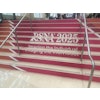As a professional medical historian, Nancy Knight knows a little digging can reveal a few skeletons in the closet. But sometimes even she finds herself surprised.
"I once had lunch with a (retired radiologist) at his home in Winnetka, IL," said Knight, former historian for the American College of Radiology of Reston, VA. "He was so excited about our talk that he showed me his old radium needles. They were still full of radium and hot as can be."
Radium needles in the closet may be a little extreme, but management consultants say the history of a practice can be vital to its future.
"How do you talk about yourself if you can't document where you're coming from?" asked Penny Pence Smith of Medical Marketing Management in Chapel Hill, NC, speaking at the Economics of Diagnostic Imaging conference in October.
The benefits of a practice history are manifold. A history can provide:
A history, Knight said, can answer the most basic questions about a practice: Who, What, Why, Where and When?
Unfortunately, not many practices maintain an organized compilation. A written or oral history does require time and effort to put together, but the benefits of having a documented narrative - covering financial, legal, personnel and publishing matters - make it worthwhile. (Patient records will be discussed in an upcoming feature on AuntMinnie.com.)
Getting started
Whether the practice is 100 years or 100 days old, the first step is to find someone to do the legwork. Professional historians are one option; a group member with some initiative is another.
"Quite often, there's somebody in your practice who loves to do research or who is good on the Web," Knight said. Another option, especially if the practice is affiliated with a university, is to recruit graduate students who are looking for a little extra credit or cash.
Once an organizer has been designated, the next step is to look at in-house records: legal documents, bank statements, correspondence, human resource files.
Records maintained by lawyers, accountants, hospital administrators and referring physicians may also make for fruitful sources. Professional organizations such as the Radiological Society of North America (www.rsna.org) and the American College of Radiology (www.acr.org) keep archives; the Index Medicus documents articles published by partners.
Another place to check is local newspapers, as articles on professional activities and charitable events can house a plethora of insights, Knight said. Even the Yellow Pages, both old and current, can yield information on various locations of the practice.
As morbid as it may seem, "obituaries are one of the best sources of information," Knight said. "Frankly, I think it's a good idea to keep up-to-date obits on living staff members. The last thing you want to find yourself doing (in the event of a death) is scrounging around for someone's birthplace or age."
If time permits, interviewing retired and active group members can give a history some color, although differentiating between anecdotes and idle chatter is crucial.
"It's one thing to add something to the mythology of your practice because it's fun," Smith said, but "the last thing you want to is commit to paper and make a fact out of something that may not have been."
Legally, what are the ramifications of keeping a practice history? As with any document, accuracy is the best safeguard, said Otha Linton, executive director of the International Society of Radiologists (http://www.his.com/~isr).
Linton recently completed a 120,000-word history for the radiology department at the Hospital of the University of Pennsylvania.
"While we were working on the (UPenn) history, we had a motto: 'We don't have to put everything in, but what we put in needs to be right.' You always run the theoretical risk that somebody is going to dislike something that you've written," he said. "If you can write as much from source material as possible, then do that."
Once the data has been collected, deciphering what information should be kept is essential: Pictures from the annual holiday parties may be entertaining, but they don't have a lot of value, Knight pointed out.
"Physically, what you don't want is a giant room full of stuff that the next people in the practice just want to get rid off," she added.
Databases and a CD-ROM are two options, particularly because the latter allows for the storage of photos. If someone is feeling very creative, an old-fashioned time capsule that can be updated periodically is another way to go. If time is an issue, full sentences aren't necessary; bullet points or a timeline will work as well, Smith said.
However the end result is packaged, a well-documented history can be an excellent marketing tool for future growth, Smith said. "It adds more credibility to your practice. It says, 'We have a history and we care enough about our practice to keep an eye on it.'"
By Shalmali PalAuntMinnie.com staff writer
December 13, 1999



















